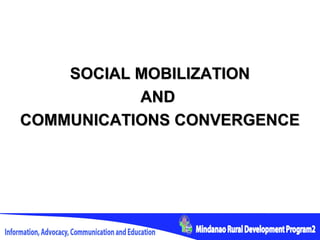Soc mobyear2
- 1. SOCIAL MOBILIZATION AND COMMUNICATIONS CONVERGENCE
- 2. Social Mobilization by Sherwin B. Manual Information and Advocacy Specialist Mindanao Rural Development Program
- 3. Outline • Social Mobilization – Definition – Elements – Soc Mob in Action • Communications Networking – Functions of Network – Successful Networking
- 4. What is Social Mobilization? It is used to describe a comprehensive planning approach that emphasizes political coalition building and community action (UNICEF 1993, Wallack 1989)
- 5. What is Social Mobilization? The process of bringing together all feasible and practical inter-sectoral and social allies to raise people’s awareness of the demand for a particular development program; to assist in the delivery of resources and services; and to strengthen community participation for sustainability and self-reliance (McKee, 1992)
- 6. What is Social mobilization? The act of rallying together as many social allies – government leaders, non-government organizations, civil society, business sector own and support certain development program.
- 7. Social Mobilization • Mobilization is a process through which community members become aware of a problem, identify the problem as a high priority for community action, and decide steps to take action (Thompson and Pertschuk 1992).
- 8. Social Mobilization • Central to social mobilization interventions is empowerment or the process through which individuals or communities take direct control over their lives and environment (Minkler 1990).
- 9. Elements of social mobilization • Advocacy • Information, Education and Communication (IEC) • Community Organization • Capacity Building • Monitoring and evaluation • Networking and Alliance Building
- 10. Soc Mob in Action The situation • San Aquilino is a third class municipality in Davao Oriental. It lies along the coastal area. The main source of income is fishing.
- 11. The Idea Mayor Mando intends to protect the town’s mangrove forest. He summons the MENRO and the Municipal Planning and Development Officer to present with options. The MENRO and MPDO suggest that they take the Natural Resources Management of MRDP.
- 12. The Machinery • The MENRO approaches Ka Nonoy, the head of San Aquilino’s MAFC to propose the idea. Ka Nonoy calls a meeting of the MAFC the following Saturday.
- 13. The Sales Pitch In the meeting, the MENRO discusses the features of the Natural Resources Management. He explains how, fish sanctuary and mangrove rehabilitation along with the possible alternative livelihood could improve and sustain their income.
- 14. The Task force Among those who attended the meeting are: Mang Ben, a fisherfolk leader; Mrs. Bella, school principal and head of the mother’s club. Mr. Danilo head of K of C; Brgy, Capt. Sonny; Ka Andres, rebel returnee; and Ms. Malou NGO leader. They form of the SocMob Task Force.
- 15. The Moves The Move (1) The task force moves swiftly the following day. Based on materials provided by Menro. Ms. Malou prepares a wall newspaper on NRM and materials for mangrove protection . Brgy. Capt. Sonny enjoins his council to push for advocacy through announcements like “rekoreda and purok meetings”
- 16. The Move 2 • Ka Nonoy and the MPDC discuss with Mayor Mando as to how the people can be organized and draw support from the community. They also discuss the financial management of the project to properly implement it.
- 17. The Move (3) • Mang Ben spread the word to his fellow fishermen in informal pulong-pulongs. He meets with his coop with staff to see how operations can be modified to accommodate the possible livelihood projects in the project. He xeroxes materials form the MENRO and distributes these to his friends and neighbors.
- 18. The move 4 • Mr. Danilo solicited the support of the parish priest who devoted his sermons for the next two months on the importance and the God- given responsibilities of the people to protect and conserve the environment.
- 19. The Move 5 • For her part Mrs. Bella requests her Agriculture and Science teachers to prepare a short lesson plan on protecting the environment and sustainable agricultural practices for their high school students with instructions to talk to their parents about it. • She begins to organize a coastal visit and clean-up in two months to reinforce the lessons of the teachers.
- 20. The move 6 • In the meantime, Ka Andres sends feelers to his former comrades in the hills not to derail but rather support their program in the upland and coastal areas.
- 21. The move (7) • The Task force, as a whole, encouraged their respective sectors to rally behind the aims and objectives of the NRM projects.
- 23. Communication Networking by Sherwin B. Manual Information and Advocacy Specialist Mindanao Rural Development Program
- 24. Understanding Networking • Network – is a group of individuals or institutions linked together because of a commitment to collaborate in solving a common problem or set of problems and to use existing resources more effectively.
- 25. Understanding Networking Networking is a rational approach to maximize the resources and concerned entities involved in the communication plan. Avoids duplication of efforts and strengthens weaknesses
- 26. Functions of Networks Individuals or organizations network to: • Identify, address, and solve a common problem; • Provide general support (technical & financial/resources for their programs/activities); • solidify partnerships, reduce isolation, and allow interaction
- 27. Traits of Successful Networks • a well-defined theme or strategy • an important, widely shared objectives or problem; • a strong and effective coordination; • a strong education and training;
- 28. Traits of Successful Networks • a strong membership support (commitment of funds, resources, & staff, strong interest served); • flexibility outside funding
- 29. Personnel Mass Com Mass Com Expertise Technology/ Equipment/ Program Technology Regional Writer, Newsletter Printer, Camera Office Videographer Province Radio Radio Program Camera Broadcaster Radio station Municipality Cameraman, Bulletin Board Camera Speech writer
- 30. Daghang Salamat!






























